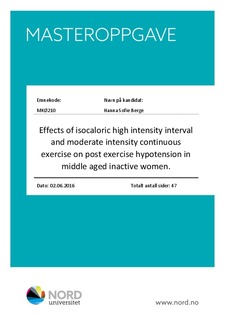| dc.description.abstract | Hensikten med denne oppgaven var å studere om isokalorisk høyintensiv intervalltrening (INT) kunne gi en større og lengre post exercise hypotensjon (PEH) effekt enn kontinuerlig trening med moderat intensitet (CON). Seks friske kvinner med høyt normalt blodtrykk (BT) i en alder av 56 ± 6 år gjennomførte denne studien. Totalt tre tester ble utført, en test av maksimalt oksygenopptak etterfulgt av INT og CON. Designet brukt i denne studien var et kontrollert cross-over within-participants design, hvor deltagerne selv var sin egen kontroll. Før, under og etter INT og CON ble BT målt kontinuerlig. Etter INT og CON, ble BT målt i 30minutter mens deltagerne satt i en stol. Hovedfunnene var ingen signifikant forskjell mellom INT og CON på PEH. Det var heller ingen signifikant PEH, men med justering for multiple sammenligninger var det systoliske BT 30 minutter etter trening lavere enn BT i hvile før trening (gjennomsnitt differanse: -18mmHg, 95% CI: -29.1 til 8.1, p < 0.006). Diastolisk BT og GAT målt 5minutter etter trening var også lavere enn BT i hvile (gjennomsnitt differanse: -5 mmHg, 95% CI: -9.4 til -0.7 p < 0.03) (gjennomsnitt differanse: -8 mmHg, 95% CI: -12.1 til -3.3 p < 0.006). Total perifer motstand (TPM) derimot var signifikant lavere 5minutter etter trening sammenlignet med målingen tatt i hvile (p <0.05). Funnen fra denne studien demonstrerer at fysisk aktivitet kan redusere systolisk og diastolisk BT, GAT og TPM etter høyintensiv isokalorisk INT og moderat CON trening, men at intensiteten ikke var viktig i styringen av PEH responsen.
Abstract
The purpose of this thesis was to study whether isocaloric high intensity interval exercise (INT) could cause a lager and longer post exercise hypotension (PEH) effect than continuous exercise with moderate intensity (CON). Six healthy women with high normal blood pressure (BP) at the age of 56 ± 6 conducted this study. A total of three tests were completed, one test of maximal oxygen uptake followed by INT and CON. Design used in this study was a controlled cross-over within- participants design, where the participants were their own control. Before, during and after the INT and CON were the BP measured continuously. After the INT and CON, BP were measured for 30min while the participants sat in a chair. Main findings were no significant difference between INT and CON on PEH. There were also no significant PEH, but with adjustment for multiple comparisons the systolic BP 30 min post exercise was lower than the BP in rest (mean diff.: -18.6 mmHg, 95% CI: -29.1 to -8.1, p < 0.006). Diastolic BP and MAP measured 5min post exercise was also lower than BP in rest (Mean diff: -5 mmHg, 95% CI: -9.4 to -0.7 p < 0.03) (mean diff: - 8 mmHg, 95% CI: -12.1 to -3.3 p < 0.006). Total peripheral resistance (TPR) was significantly reduced 5minutes post exercise compared to the value in rest (p <0.05). The findings from this study demonstrates that physical exercise can reduce systolic and diastolic BP, MAP and TPR after isocaloric high intensity INT and moderate intensity CON exercise, but that the intensity was not important in governing the PEH response. | nb_NO |
